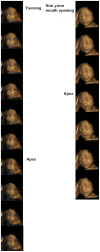Development of fetal yawn compared with non-yawn mouth openings from 24-36 weeks gestation
- PMID: 23185638
- PMCID: PMC3503956
- DOI: 10.1371/journal.pone.0050569
Development of fetal yawn compared with non-yawn mouth openings from 24-36 weeks gestation
Abstract
Background: Although some research suggests that fetuses yawn, others disagree arguing that is it simple mouth opening. Furthermore there is no developmental account of fetal yawning compared with simple mouth opening. The aim of the present study was to establish in a repeated measures design the development of fetal yawning compared with simple mouth opening.
Methodology/findings: Video recordings were made of the fetal face and upper torso visualized by means of 4D full frontal or facial profile ultrasound recordings. Fifteen healthy fetuses were scanned four times at 24, 28, 32 and 36 weeks gestation. Yawning was distinguished from non-yawning in terms of the length of time it took to reach the apex of the mouth stretch, with yawns being defined as more than 50% of the total time observed. To assess changes in frequency, a Poisson mixed effects model was fitted to the count of number of yawn and simple mouth opening events with age and gender as fixed effects, and person as a random effect. For both yawns and simple mouth openings a smooth varying age effect was significant. The number of yawns observed declined with age from 28 weeks gestation, whereas simple mouth openings were less frequent and the decline was observed from 24 weeks. Gender was not significant either for yawn and simple mouth openings.
Conclusions/significance: Yawning can be reliably distinguished from other forms of mouth opening with the potential of using yawning as an index of fetal healthy development.
Conflict of interest statement
Figures



Similar articles
-
Identifying fetal yawns based on temporal dynamics of mouth openings: A preterm neonate model using support vector machines (SVMs).PLoS One. 2019 Dec 19;14(12):e0226921. doi: 10.1371/journal.pone.0226921. eCollection 2019. PLoS One. 2019. PMID: 31856250 Free PMC article.
-
Variation and context of yawns in captive chimpanzees (Pan troglodytes).Am J Primatol. 2010 Mar;72(3):262-9. doi: 10.1002/ajp.20781. Am J Primatol. 2010. PMID: 20014109 Free PMC article.
-
Yawning frequency and distribution in preterm and near term infants assessed throughout 24-h recordings.Infant Behav Dev. 2007 Dec;30(4):641-7. doi: 10.1016/j.infbeh.2007.03.005. Epub 2007 Apr 5. Infant Behav Dev. 2007. PMID: 17418421
-
Why do we yawn? The importance of evidence for specific yawn-induced effects.Neurosci Biobehav Rev. 2011 Apr;35(5):1302-4. doi: 10.1016/j.neubiorev.2010.12.004. Epub 2010 Dec 17. Neurosci Biobehav Rev. 2011. PMID: 21168437 Review.
-
Non-human primates: a comparative developmental perspective on yawning.Front Neurol Neurosci. 2010;28:63-76. doi: 10.1159/000307082. Epub 2010 Mar 26. Front Neurol Neurosci. 2010. PMID: 20357464 Review.
Cited by
-
Prenatal effects of maternal nutritional stress and mental health on the fetal movement profile.Arch Gynecol Obstet. 2020 Jul;302(1):65-75. doi: 10.1007/s00404-020-05571-w. Epub 2020 May 14. Arch Gynecol Obstet. 2020. PMID: 32409928 Free PMC article.
-
Identifying fetal yawns based on temporal dynamics of mouth openings: A preterm neonate model using support vector machines (SVMs).PLoS One. 2019 Dec 19;14(12):e0226921. doi: 10.1371/journal.pone.0226921. eCollection 2019. PLoS One. 2019. PMID: 31856250 Free PMC article.
-
Factors affecting yawning frequencies in preterm neonates.PLoS One. 2022 May 6;17(5):e0268083. doi: 10.1371/journal.pone.0268083. eCollection 2022. PLoS One. 2022. PMID: 35522682 Free PMC article.
-
Fetal Behavioural Responses to Maternal Voice and Touch.PLoS One. 2015 Jun 8;10(6):e0129118. doi: 10.1371/journal.pone.0129118. eCollection 2015. PLoS One. 2015. PMID: 26053388 Free PMC article.
-
Infant brain activity in response to yawning using functional near-infrared spectroscopy.Sci Rep. 2019 Jul 23;9(1):10631. doi: 10.1038/s41598-019-47129-0. Sci Rep. 2019. PMID: 31337824 Free PMC article.
References
-
- De Vries JIP, Visser GHA, Prechtl HFR (1982) The emergence of fetal behaviour. I. Qualitative aspects. Early Hum Dev 7: 301–322. - PubMed
-
- Guggisberg AG, Mathis J, Schnider A, Hess CW (2011) Why do we yawn? The importance of evidence for specific yawn-induced effects. Neurosci Biobeha R 35: 1302–1304. - PubMed
-
- Provine RR (2005) Yawning. Am Sci 3: 532–539.
-
- Argiolas A, Melis MR, Gessa GL (1986) Oxytocin: an extremely potent inducer of penile erection and yawning in male rats. Eur J Pharmacol 130: 265–272. - PubMed
Publication types
MeSH terms
LinkOut - more resources
Full Text Sources
Miscellaneous

